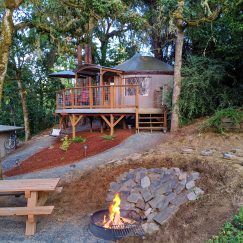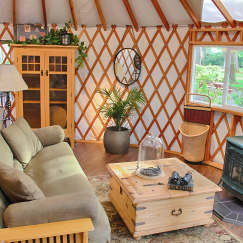Pacific Yurts’ Yurts Endure Feature
Every once in a while, some great press rolls along and we can’t help but share it with you! Recently we were featured in the Register-Guard in an article by Winston Ross called Yurts Endure:
COTTAGE GROVE — A few feet inside the warehouses, it smells like any other wood products manufacturing center: sawdust. But what’s neatly stacked this way and that are no ordinary two-by-fours. They’re curved.
Welcome to Pacific Yurts, a Lane County company that has been the industry leader in the yurt-making business since yurt making became a business, at least on a major scale. Which makes sense, really, because before a young college graduate named Alan Bair spotted a National Geographic article on Central Asia 40 years ago, these funny-looking round structures were the stuff of nomadic sheepherders.
Those yurts were fashioned from tree saplings strung together with a woven tension band, a central ring at the apex of the “ceiling,” and animal skins stretched around the structure to keep out the wind, rain and snow. What Bair liked was its surface-to-volume ratio, its efficient use of material, and its simplicity. He decided to build one for himself.
Fast forward to 2012, and the Cottage Grove company finds itself smartly positioned to capitalize on a bevy of trends both American and international, from the desire for inexpensive vacation housing to green recreation to downsized lifestyles to year-round camping. It’s why Pacific Yurts survived the Great Recession when another Lane County yurt maker, Mindful Living, didn’t. And it’s why Bair sees a bright future for himself and his 25 to 30 employees.
…
Business grew steadily via word of mouth, before Bair got his first big break. In 1994, the Oregon Parks and Recreation Department bought two of his yurts to install in its campgrounds, an effort to lure lovers of the outdoors who wanted to avoid pitching their tents in the rain. The yurts were immediately popular, and profitable, which is why over the next 20 years, the parks department bought nearly 200 more yurts.
“We’ve been very impressed with how they hold up, both to different weather conditions and visitors — both of which are strong natural forces that can really test equipment,” said parks spokesman Chris Havel. “And they open up state parks to a whole new audience. It extends the camping season so it’s a year-round activity, no matter what your tolerance is for weather.”
…


